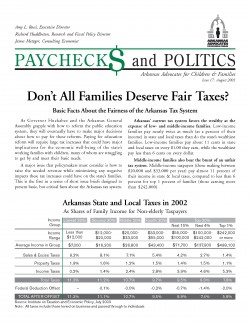
As Governor Huckabee and the Arkansas General Assembly grapple with how to reform the public education system, they will eventually have to make major decisions about how to pay for these reforms. Paying for education reform will require large tax increases that could have major implications for the economic well-being of the state’s working families with children, many of whom are struggling to get by and meet their basic needs.
A major issue that policymakers must consider is how to raise the needed revenue while minimizing any negative impacts these tax increases could have on the state’s families. This is the first in a series of short issue briefs designed to present basic, but critical facts about the Arkansas tax system.
Arkansas’ current tax system favors the wealthy at the expense of low- and middle-income families. Low-income families pay nearly twice as much (as a percent of their income) in state and local taxes than do the state’s wealthiest families. Low-income families pay about 11 cents in state and local taxes on every $1.00 they earn, while the wealthiest pay less than 6 cents on every dollar.
Middle-income families also bear the brunt of an unfair tax system. Middle-income taxpayers (those making between $20,000 and $33,000 per year) pay almost 11 percent of their income in state & local taxes, compared to less than 6 percent for top 1 percent of families (those earning more than $242,000).
